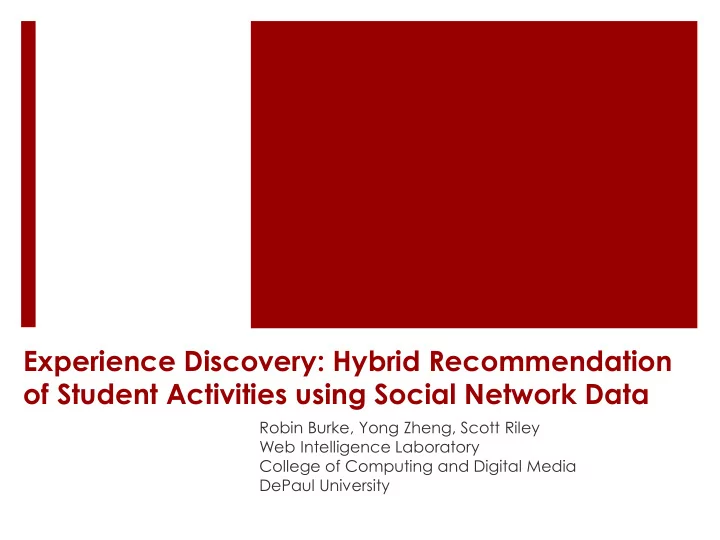

Experience Discovery: Hybrid Recommendation of Student Activities using Social Network Data Robin Burke, Yong Zheng, Scott Riley Web Intelligence Laboratory College of Computing and Digital Media DePaul University
Problem Service organizations offer many educational programs and activities for youth Participation (especially by underprivileged youth) is low Even though these are the individuals who would benefit the most How to get better participation? not just a recommendation problem
The Role of Recommendation Need for personalization Many diverse activities from basketball to poetry to robots to knitting Low tolerance for imprecise results Need for system initiative user research shows that students are unlikely to search and browse To “pull” opportunities system should “push” suggestions we are considering mobile platforms
Partners Digital Youth Network service organization focused on the creation of digital media Nichole Pinkard YouMedia school-based online social network affiliated with DYN Chicago Learning Network consortium of museums and non-profits Chicago Public Schools Funders MacArthur Foundation Gates Foundation
Experience Discovery: Research opportunities Full cycle observation activity enrollments activity attendance click-through post-activity rating, tagging, reviewing Social network data uploading of digital media browsing / commenting behavior friend / follower connections
Research question 1 There are multiple important knowledge sources past enrollment history content data social network data log data Mixed vs integrated hybrid recommendation should different knowledge sources be integrated in making recommendations? or should recommendations of different types be presented side-by-side?
Research question 2 Activities sometimes have a logical planned sequence Video editing I -> Video editing II Sometimes they are sequenced idiosyncratically Digital photography -> Zoo explorer I Educational goal increase both depth and breadth of student participation The role of “curricula” how can recommendations be used to increase both breadth and depth of student involvement? what is the role of top-down vs bottom-up sequences in recommendation?
Research question 3 Dynamics of interest students mature a lot between 11 and 18 old activities may lose their appeal Dynamics of offerings activities change from year to year and season to season may not be explicit Coping with change how can we ensure that recommendations don’t lag student interest? how to detect and respond to program changes?
Research question 4 Students aren’t the only ones with questions Service providers can get value, too what activities should I offer and where? how do my offerings compare to other groups? what needs are not being met? Analytics and recommendations for service providers what can we provide that is helpful and comprehensible?
Architecture ! "#$% & $( 0$,- $01' ' $( 2*31( ,4+ *51% ' , ?+ & $( ), D#$% *31( *+ , 6037& )8,9*)*, 6+ A1% & )@ ' ,E& F% *% 8, 6##+ & 0*31( , > ( )$% C *0$, 6G$( 2*( 0$, 9*)*, - $01' ' $( 2*31( , - $./+ ), > ( #/), ! ( A& ( $, ?*0@ $, ! "#$% & ' $( )*+ , ?*0@ $, ?1( BA/% *31( ., : 10& *+ , ; $)< 1% =, ! 7*+ /*31( , ! "#$% & ' $( )*+ , 9*)*, > ( )$% C *0$, - $./+ ).,
Initial experiments Data (2 schools) 226 students 32 activities 3800 records (now adding ~2000 enrollments and ~50 activities / month) Algorithms collaborative / binary collaborative / pseudo rating content-collaborative meta-level hybrid plus behavioral descriptors
Pseudo-ratings Some activities are attended multiple times evidence of strong interest Example book discussion group Normalize to user’s profile weight for activity a = # of times attending a / total attendances Can we normalize in other ways? take into account how often something was offered
Meta-level hybrid Use course topic descriptors 13 choices health, music, visual arts, etc. activities may include several topics Build a topic profile by summing over descriptions of all activities Compare users based on topic profiles rather than attendance data
Adding social network data Extracted 10 features from the social network counts of uploaded media types overall level of activity Used feature combination content profile 8$93& (: . 4) $& , 0 . behavior profile ! , (, . 5"(6 ) % 7. ! "#$% & ' () % #. 1"2, 3& ) % .- , (, . ! "#$% & ' () % * +, #"- . 1"2, 3& ) % * +, #"- . ' % ) /0 ". ' % ) /0 ".
Results Temporal leave-one-out evaluation see Burke, 2010 Look at a user’s experience over time looking at users divided by # of enrollments (profile size) profile diversity (# of different enrollments) Need to do more research Hybrid 2 works best for large, diverse users Doesn’t matter what you do for non - diverse users
Conclusions We are in the early stages here Eager to get our hands on bigger data Many research questions Would like to hear ideas
Thanks Questions / Comments / Ideas
Recommend
More recommend